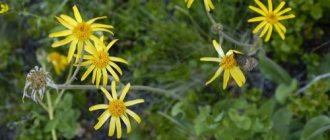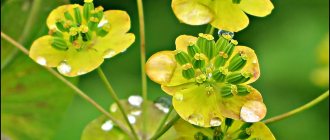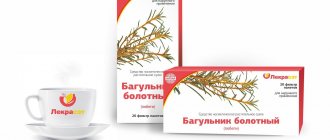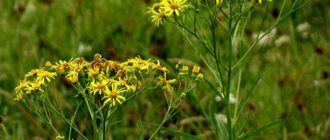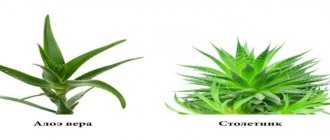The healing properties of calendula in gynecology
Calendula in gynecology is used in the form of a solution for douching and ointment. The leaves and inflorescences of calendula have a rich range of chemicals useful in the treatment of gynecological diseases:
- phytoncides - have an antiseptic effect;
- carotenoids - stimulate the immune system;
- flavonoids - remove harmful substances from the body and relieve spasms;
- saponins - calm the nervous system;
- essential oil - normalizes the activity of the endocrine system;
- mucus - envelops the walls of the vagina and relieves itching;
- bitter substances - accelerate metabolic processes.
Thanks to its composition, calendula relieves discomfort due to microflora disorders, relieves inflammation and promotes the healing of abrasions on the inner walls of the vagina. A decoction of the plant relieves pain during menstruation, reduces the amount of bleeding and alleviates the general condition during menopause.
Types of calendula oil and its composition
During the process of extraction or maceration, all biologically active substances pass into the yellow-orange liquid. They determine the quality of the oil and its scope of application. The list of useful components:
- essential oils that counteract pathogenic microflora;
- carotenoids, which stimulate the production of vitamin A in the body;
- coumarins, which suppress inflammatory processes of various nature;
- sterols that replace harmful cholesterol in the body and resist the development of atherosclerosis and other diseases of the heart and vascular systems;
- flavonoids, which have antispasmodic, diuretic and choleretic properties, affecting the gastrointestinal tract and nervous system, cleansing the body of toxins;
- triterpenoids that relieve inflammation and stimulate wound healing.
The flowers impart a wide range of minerals to calendula oil, including potassium and calcium, selenium and zinc, iron and magnesium.
What is douching
A medical bulb is used for douching. Douching is the washing of the vaginal walls with a herbal medicinal solution, anti-inflammatory and antiseptic drugs for the treatment or prevention of gynecological diseases. The procedure is carried out using a medical bulb, syringe, special syringe or Esmarch mug.
Calendula for douching in gynecology
Calendula solution for douching is prescribed if the vaginal microflora deviates from the norm, as well as for the following diseases:
- trichomonas colpitis;
- candidiasis;
- cervical erosion;
- delayed menstruation due to inflammation.
Calendula for douching in gynecology relieves burning and itching and destroys pathogenic microorganisms . However, frequent use of the solution may cause the opposite effect. Whatever the medicinal properties of calendula in gynecology, it washes away the natural lubricant and inhibits beneficial microflora. With constant douching, the vaginal tissue becomes dry and irritated and loses its protective functions. Therefore, the procedure cannot be carried out longer than 5 days.
Calendula solution for douching
Ingredients:
- Dried calendula flowers - 2 tsp.
- Water - 2 glasses.
How to prepare : Boil water and pour into a jar. Pour dried flowers into boiling water and close the lid tightly. Leave the broth for 1.5 hours, then strain through cheesecloth.
How to use : For the procedure, dilute the decoction with clean water in a 1:1 ratio.
Result : The solution neutralizes inflammation, destroys fungal bacteria and restores the natural microflora in the vagina.
There is also another way to prepare a solution for douching.
Ingredients:
- Dried calendula flowers - 1 tbsp.
- Alcohol 70% - ½ cup.
How to prepare : Pour dried flowers with alcohol and leave in a dark place for 14 days. Carefully strain the solution through a thick cloth or gauze.
How to use : When douching, dilute the tincture in the proportions of 1 tsp. solution per 1 glass of warm boiled water.
Result : Alcohol tincture of calendula in gynecology has a rapid anti-inflammatory and bactericidal effect, relieves itching and irritation.
Treating thrush with calendula
Calendula helps well with thrush, as it has a bactericidal and disinfectant effect. For treatment, it is used in different forms, for example in the form of oil, which has a pronounced antimicrobial effect and is very effective in combating the problem. There are many folk recipes for thrush based on calendula. Before starting treatment, you need to familiarize yourself with the proven and most effective ones. So:
- Douching with herbal decoction. It is not difficult to prepare a decoction of calendula: you need to pour 1-2 tbsp. l. dry herbs 200 ml of boiling water, cover the container with a lid and leave the composition to infuse for 2-3 hours, then strain it through a sieve. For douching, you need to dilute the infusion with boiled water in a 1:1 ratio. It can also be used for washing. It is worth noting that the douching procedure cannot be done more than 2-3 times a day, since the liquid washes out not only the fungi that cause the disease, but also beneficial bacteria. Relief should occur in 3-5 days. Abuse of douching can provoke vaginal dysbiosis.
- Baths with calendula tincture are prescribed if the inflammation has spread to the vulva area. For the procedure, you can use the same decoction as for douching, but you will need a larger amount of infusion. It is most convenient to make a bath in a basin by mixing the broth with boiled water in a 1:1 ratio. It is enough to do 1-2 procedures a day until the symptoms of thrush begin to disappear.
- Tampons with calendula. To prepare them, you will need to mix 2% calendula tincture and settled water at the rate of 2 ml of medicine per 100 ml of liquid. A cotton swab should be moistened in the prepared solution and inserted into the vagina overnight.
Read also…. Sex with thrush: is it possible to have sex with thrush?
In most cases, several procedures are enough to relieve the acute symptoms of thrush, reduce itching and burning. Many experts agree that taking calendula decoction orally helps speed up the healing process. It helps not only to eliminate the external manifestations of the disease, but also to strengthen the body’s defenses, which are necessary to fight it from the inside.
The undoubted advantage of calendula is its safety and the absence of contraindications. In addition, it extremely rarely causes allergies, so it is often prescribed to pregnant women. Before starting treatment, it is recommended to consult a doctor. It is worth visiting a specialist even if relief does not occur within 2-3 days.
BENEFICIAL FEATURES
Calendula officinalis, popularly called marigold, is included in the Medicinal Pharmacopoeia of the Russian Federation. The flowers of the plant are considered healing.
The medicinal properties of the plant include:
- reduction of inflammatory phenomena;
- bactericidal effect;
- tissue regeneration;
- antivirus;
- hypotensive;
- choleretic;
- astringent;
- helping to reduce spasms.
Thus, for thrush, topical application of calendula will help reduce inflammation and improve healing.
Rules for the procedure
When treating cervical erosion, start douching the day after your period ends. In other cases of using calendula in gynecology, do douching immediately after diagnosis.
For a single procedure, 200 ml of calendula solution is sufficient.
How to do douching:
- Wash the bulb with the tip, pour boiling water over it and dry with a towel.
- Heat the solution to a temperature of 37-40 degrees and fill the pear with it.
- Lubricate the tip of the bulb with Vaseline.
- Lie on your back in the bathtub, bend your knees and spread them apart.
- Insert the tip into the vaginal cavity to a depth of 7 cm. If you feel muscle tension, wait, and it will go away in a minute.
- Press the bulb, gently squeezing the broth into the vagina. Move slowly and measuredly, do not increase the pressure, so as not to cause inflammation of the uterus due to accidental fluid entering its cavity.
- The procedure lasts 15-20 minutes until you squeeze out all the broth.
- Wash off any remaining solution from the outside of your vagina with water and liquid soap.
Do the procedure morning and evening for 5 days. If a burning sensation begins during douching, rinse your vagina with water. If you feel itching, pain, or see bleeding after the procedure, consult your doctor.
Remember two important rules:
- Douching with calendula solution helps in the treatment of gynecological diseases only in combination with other drugs and procedures.
- Unsystematic use of douching can be harmful to health. Before starting the procedure, consult your doctor. He will refer you for tests and, depending on the diagnosis, prescribe an individual treatment regimen.
Uses of calendula in other forms
Douching with calendula decoction is often complemented by a bath with the same solution. Such bathing helps in the treatment of colpitis, inflammation of the uterine cavity and vagina.
Instead of douching, doctors prescribe vaginal suppositories with calendula. They have the same anti-inflammatory and wound-healing effect, destroy microbes, relieve burning and pain during menopause and do not wash out normal, non-pathogenic bacteria from the vagina.
Calendula oil is used in case of painful periods, to treat cervical erosion, leucorrhoea, fungal vulvitis, colpitis and other gynecological diseases. Cotton-gauze swabs are soaked in oil, inserted into the vagina and kept overnight. The course lasts 1 week.
Calendula ointment in the treatment of female diseases
You can prepare calendula ointment yourself. Calendula ointment is used in gynecology to heal cracks and wounds on the nipples that appear in women during the lactation period.
Ingredients :
- Calendula flowers - 1 tbsp.
- Vaseline - 4 tbsp.
How to prepare : Grind the flowers into powder and sift. Mix the resulting powder with Vaseline, place in a saucepan over a water bath and heat until the mass becomes homogeneous. Stir the mixture constantly with a wooden spatula. Cool the ointment and transfer it to a glass jar with a tight lid.
How to use : Apply ointment to the nipple area every day.
Result : A mixture of calendula and Vaseline reduces pain and inflammation, tightens the edges of wounds, relieves burning, itching and restores damaged tissue.
Diagnosis of the disease
Diagnosis of thrush is quite simple and is based on the clinical manifestations of this disease. To confirm the diagnosis, the doctor may perform light microscopy. Other methods for determining the fungus are of no practical importance, since it is important for the doctor to know the number of fungi, and not the fact of their presence.
When examined in a gynecological chair, the doctor assesses the condition of the vaginal skin, the presence of redness and swelling of the mucous membrane, cracks and abrasions. Also, with thrush, a whitish discharge forms on the walls of the genital organ, which is quite difficult to remove. If this is possible, small bruises remain on the mucous membrane, which constantly itch. The result of a vaginal smear shows the presence of threads of fungus, or mycelium.
To differentiate the disease from other pathologies, the following studies are prescribed:
- smear from the urethra, rectum, vaginal discharge;
- culture on medium;
- serological reactions (agglutination, complement fixation, precipitation);
- linked immunosorbent assay;
- PCR.
The most efficient method for identifying fungi is the examination of smears, both fresh and Gram-stained. The laboratory can conduct an immunofluorescent study, allowing a specialist to accurately determine the presence of Candida fungi.
Sowing on the medium is considered quite informative, with the help of which they determine not only the presence of fungi, but also their type, as well as sensitivity to drugs.
Many diseases of the genital area in women are accompanied by the presence of discharge. In most cases, different infections in the vagina and uterus have similar symptoms. However, vaginal mycosis is expressed by specific symptoms. In addition to severe itching in the intimate area, the genital tract contains a milky cheesy discharge with a sharp sour odor.
The amount of vaginal discharge increases with increased physical activity, during sexual intercourse, in hot weather, and also at night. Severe itching and burning in the perineum and inner thighs causes a feeling of discomfort. Unpleasant symptoms of the disease disrupt a woman’s overall well-being and reduce her social and sexual activity.
It will not be difficult for an experienced specialist to identify a disease caused by yeast. If you seek medical help in a timely manner, when the symptoms of a fungal infection are just beginning to progress, in most cases a visual examination on a gynecological chair is sufficient. In advanced or complicated forms of the disease, a more thorough examination of the body will be required to determine the type of pathogen and the cause of the pathology.
The set of diagnostic measures to identify vaginal mycosis includes the following procedures:
- taking a smear for testing for pathogenic flora;
- bacteriological culture from the cervical canal;
- collecting data on existing systemic diseases and sexual contacts to compile an anamnesis.
When making a diagnosis, it is important to identify the infection. Before starting treatment, it is necessary to exclude the presence of pathogenic bacterial flora. Yeast fungi often multiply against the background of the development of vaginal colpitis caused by trichomonas, clostridia, and various opportunistic flora. For mixed infections, the treatment regimen differs from the treatment of vaginal mycosis.
During a gynecological examination, the following are observed:
- redness and swelling of the vulva;
- increased bleeding of mucous membranes;
- curdled deposits on the mucous membranes.
In the smear: the presence of spores or mycelium of fungi of the genus Candida. If necessary, the gynecologist may prescribe a more in-depth examination, including:
- bacteriological culture;
- serological tests - RP, RSK, RA;
- polymerase chain reaction (PCR);
- enzyme immunoassay (ELISA).
Most often, fungal infection of the genital organs is clearly visible during external examination. To confirm the diagnosis, they take a smear for microscopy, culture the biomaterial for fungi and sensitivity to antimycotics; in the case of long-term erosions, a biopsy may be performed to exclude an oncological process.
• blood for sugar, • clinical analysis of blood, urine, • examination for HIV, syphilis, • feces for intestinal dysbiosis, • immunogram, • smear for STIs.
Please note that the partner must be examined and, if necessary, antifungal therapy is prescribed.
Contraindications
Regardless of the form of use of the plant - decoction, suppositories, calendula ointment in gynecology, the use of the medicine is limited by contraindications:
- allergic reaction to the Asteraceae family;
- pregnancy;
- the period after childbirth or termination of pregnancy;
- acute diseases of the reproductive system;
- diseases of the biliary tract;
- hypotension.
Douching with calendula is also not recommended for women over 45 years of age and during menopause due to increased vaginal dryness.
Features of calendula
During pregnancy, you should never self-medicate. When candidiasis occurs, the emphasis is on the use of topical drugs, and at a later date, systemic drugs that do not have a harmful effect on the fetus can be prescribed.
Among medicinal plants, calendula takes pride of place as an antiseptic herb. It is not inferior in popularity in folk and traditional medicine to chamomile, plantain, sage, licorice, marshmallow, St. John's wort, oak bark and other medicinal herbs with antiseptic action.




